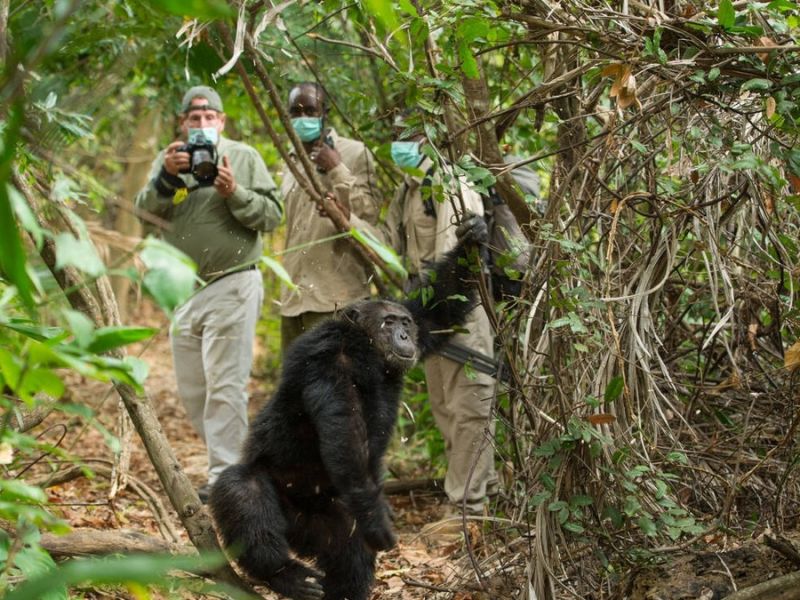
Gombe Stream National Park, one of Tanzania’s smallest yet most iconic parks, covers just 35 square kilometers along the shores of Lake Tanganyika in western Tanzania. Established in 1968, it gained global fame as the site of Dr. Jane Goodall’s groundbreaking chimpanzee research, begun in 1960, which transformed our understanding of primate behavior. The park’s lush rainforests, steep valleys, and sandy beaches are home to approximately 100–150 wild chimpanzees, making it a premier destination for chimpanzee trekking. Beyond chimps, Gombe hosts other primates like olive baboons, red colobus monkeys, and vervet monkeys, as well as over 200 bird species, including African fish eagles and palm-nut vultures. Activities include guided chimpanzee treks (1–3 hours, led by expert trackers), hiking along forest trails, and swimming or kayaking in Lake Tanganyika’s crystal-clear waters. The park’s remote location ensures an intimate, low-tourist experience, with cultural visits to nearby villages adding a local perspective. With basic lodges and tented camps, Gombe is ideal for eco-conscious travelers seeking a unique wildlife and historical adventure.
Find out more about Gombe National Park by exploring the other tabs.
Gombe Stream National Park’s tropical climate is shaped by its location on Lake Tanganyika at an elevation of 773–1,500 meters, featuring distinct wet and dry seasons:
Dry Season (May–October): Warm days averaging 25–30°C (77–86°F) and cool nights (15–20°C, 59–68°F). Minimal rainfall ensures accessible trails for chimpanzee trekking and hiking, with clear skies ideal for lake activities like swimming and kayaking. Chimpanzees are easier to locate in sparser vegetation.
Short Dry Season (January–February): Hot and slightly humid, with daytime temperatures of 27–32°C (81–90°F) and nights around 18–22°C (64–72°F). Occasional light showers occur, but conditions remain suitable for trekking and water-based activities, with lush greenery enhancing the scenery.
Wet Season (November–April): Hot and humid, with daytime temperatures of 28–34°C (82–93°F). The long rains (March–April) bring heavy showers, making trails muddy and chimpanzee trekking challenging, though lake activities remain viable. The short rains (November–December) feature brief afternoon showers, allowing morning treks. The wet season is excellent for birdwatching, with migratory species present.
Key Notes: Pack lightweight, breathable clothing for trekking, with layers for cooler nights in the dry season. Waterproof gear and sturdy boots are essential during the wet season, along with mosquito repellent. The equatorial climate ensures consistent daylight hours, with sunrise around 6:30 AM and sunset around 6:30 PM year-round.
Weather conditions can vary throughout the year at Gombe National Park.
Gombe Stream National Park is remote, accessible primarily via Kigoma, a town on Lake Tanganyika 24 km south of the park. The main international gateway is Julius Nyerere International Airport (DAR) in Dar es Salaam, which serves flights from hubs like Doha (Qatar Airways), Istanbul (Turkish Airlines), and Nairobi (Kenya Airways). From Dar es Salaam, domestic flights to Kigoma Airport (1.5–2 hours) are operated by Air Tanzania or Auric Air. From Kigoma, access Gombe via a 45-minute boat transfer along Lake Tanganyika to the park’s entrance, arranged through lodges or tour operators. For those combining Gombe with northern Tanzania, flights from Kilimanjaro International Airport (KIA) or Arusha to Kigoma (via Dar es Salaam) take 3–4 hours. A flight from Zanzibar to Kigoma takes about 2 hours. Road access is not feasible due to the park’s lakeside location and rough terrain. Kilisherpas arranges seamless transfers, including flights to Kigoma and boat transfers to Gombe, with expert guides handling logistics and park permits for a hassle-free journey.
We can arrange transportation to Gombe National Park as part of your tour package.
The best time to visit Gombe Stream National Park depends on your priorities, particularly for chimpanzee trekking and lake activities:
May–October (Dry Season): The peak season for visiting, with dry trails, clear skies, and optimal conditions for chimpanzee trekking and lake activities like kayaking. Chimpanzees are easier to locate in thinner vegetation, but trekking permits (limited to six per group) require early booking due to high demand.
January–February (Short Dry Season): A quieter period with warm, stable weather, suitable for trekking and lake activities. Fewer visitors offer a more exclusive experience, and the lush landscapes enhance photography opportunities.
November–December (Short Rains): Brief afternoon showers allow for morning trekking and lake activities. The park is less crowded, and lower lodge rates make this a budget-friendly time, with vibrant greenery and active birdlife.
March–April (Long Rains): Heavy rainfall makes trails slippery, complicating chimpanzee trekking, though lake activities like boat trips remain feasible. The park is quiet, and discounted rates appeal to birdwatchers and those prioritizing solitude.
For the ultimate Gombe experience, plan a 2–4 day visit during the dry season (May–October) to maximize chimpanzee trekking success and enjoy Lake Tanganyika’s activities. Combine with nearby Mahale Mountains National Park for a twin chimpanzee adventure or a Zanzibar beach getaway for a diverse Tanzania itinerary. Contact Kilisherpas to craft a personalized itinerary with expert guides, ensuring an unforgettable journey into Gombe’s chimpanzee haven!
Book your visit during these recommended times for the best experience.
